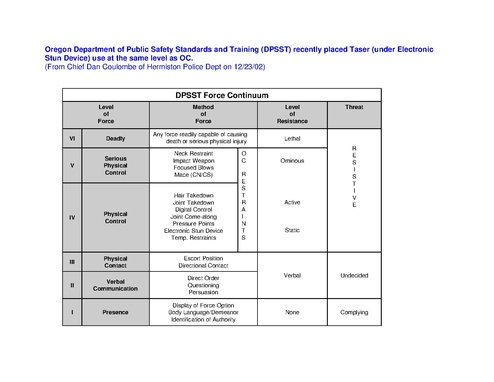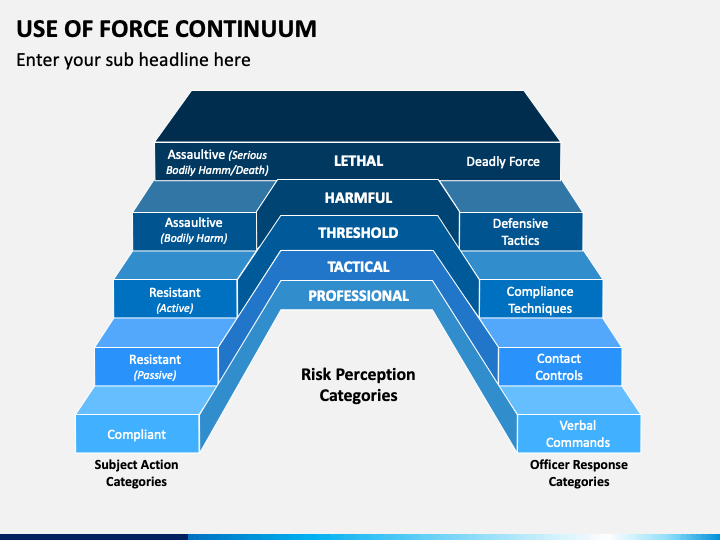The use of force continuum is a framework that guides law enforcement officers in the appropriate use of force in a given situation. It is designed to help officers determine the level of force necessary to effectively address a situation, while also taking into account the severity of the threat and the potential for injury to both the officer and the subject.
The use of force continuum typically consists of a series of escalating levels of force, ranging from verbal commands and persuasion to physical force and deadly force. The exact stages and definitions of each level may vary depending on the agency or jurisdiction, but they generally follow a similar structure.
At the lower end of the continuum are verbal commands and persuasion, which are the least intrusive methods of force. These may include requesting that a subject comply with an officer's instructions or attempting to de-escalate a situation through dialogue. If a subject is non-compliant but not actively threatening, an officer may use physical force such as grabbing or holding the subject to gain control.
If the subject becomes more resistant or actively combative, an officer may use intermediate force such as pepper spray, a baton, or a Taser. These methods are intended to incapacitate the subject and allow the officer to gain control, but they are not typically intended to cause serious injury or death.
Deadly force is considered the highest level of force on the continuum and is reserved for situations where the officer or others are in imminent danger of serious injury or death. This may include situations where the subject is armed with a weapon or has already used deadly force.
It is important to note that the use of force continuum is not a strict set of rules, but rather a guideline for officers to follow in determining the appropriate level of force in a given situation. The level of force used must be proportional to the threat presented and must be necessary to address the situation.
The use of force continuum is an important tool for law enforcement officers, as it helps to ensure that they use the appropriate level of force in a given situation and helps to reduce the risk of injury to both officers and subjects. It also helps to ensure that officers are held accountable for their actions and that their use of force is in line with department policies and procedures. Overall, the use of force continuum plays a crucial role in promoting public safety and maintaining trust between law enforcement and the community.
The Use of Force Continuum: Police, Power, and Prejudice

As a result, justice or the concept of moral correctness based on ethics, nationality, law, religion, equity, and fairness, whether grounded in human consensus or societal norms, are supposed to ensure that all members of society receive fair treatment. In one case study conducted in 2001, a team of sociologists attempted to train a 90-person police force in handling domestic violence situations of minority and immigrant groups, with mixed results. And when he pivots towards them from the shoulder, gun still at his side , they fire on him, and he falls. This could include empty hand techniques, deadly force, less than lethal tools, verbal directions, etc. As with most of our theories, this is a spectrum bookended by two extremes. In a dynamic situation when someone is actively, aggressively trying to hurt you or kill you, it's a very difficult situation to be in.
The Use of Force Continuum: A Misunderstood Law Enforcement Concept?

That number is 66% for Hispanics: 609 cities. . While the former gives offenders harsh punishment that is proportionate to their crime, the latter emphasizes taking responsibility for the effects of one's crime on others and trying to do something that makes things better for the victims. Training in such subjects as sociology and anthropology at the police academy could expand their working knowledge. These variables arise from individual characteristics, including physical traits healthy or out of shape , age, body type and even underlying medical issues that limit performance. But is "continuum" the most accurate term to describe police response options to resistance? But training is different than policy. Perhaps, in retrospect, law enforcement agencies and agents and human rights defenders and advocates should drop such generalizations and move towards forging a common goal of fighting crime and criminality firmly but fairly.
Ky Police Officers Refer to "Use

And whether I can see the body language or not, it's sometimes the first few words that come out of their mouths that give it away. How about that outstretched open hand that makes contact with an aggravated domestic violence abuser to keep him away from his victim? The raging debate in the country on the use of force by law enforcement agents has come at the right time when we are coming from a period of increased forced disappearances, mysterious executions of civilians, and unexplained killings in the alleged custody of police officers. An example of a defined continuum would be the temperature range between freezing and boiling. In a subtle attack on the Independent Policing Oversight Authority and other human rights groups fighting against the use of firearms by police to tackle the spiraling criminal trends in the country, the Inspector-General wondered why the IPOA went silent when police officers were killed in the line of duty. Situational Awareness and the Civilian Use of Force Continuum Law enforcement has long relied upon the An official use of force continuum for non-law enforcement i. He has worked in the detention, patrol and training divisions,SWATand accident investigation units.

It doesn't take long to determine who is comfortable holding the microphone. Rob's goal is to become a screenwriter, film director or producer and looks to the likes of Quentin Tarantino and Guy Ritchie for inspiration. In situations like Beavercreek, Ohio, or in Ferguson, the PIO releases statements that the officers act to the best of their ability given the parameters of often-ambiguous situations. . . A cop is not trained to see the social and cultural context behind a potential suspect, only to arrest crimes they see or crimes that are reported. Cops rolled their eyes when presented with seminars about privilege; they ignored the trainer, questioned their methods, their expertise, doodled in their notebooks, refused to follow instructions and in some cases threw away or left their workbooks behind.







